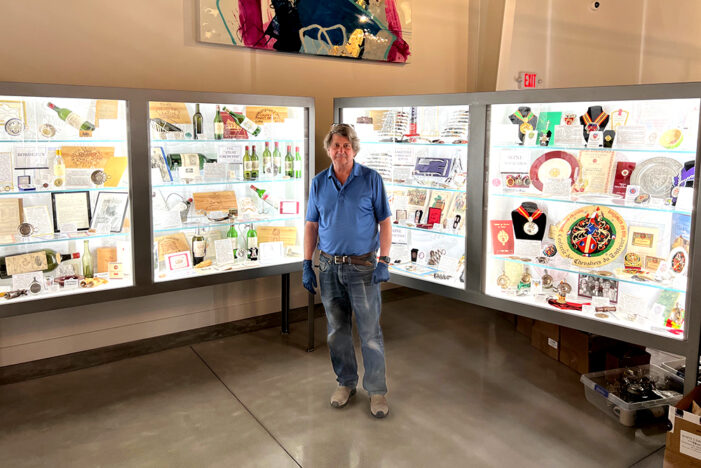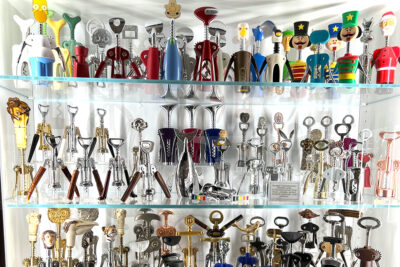
When you learn that Colterris Collections has 4,000 corkscrews on display and think, “Holy cow! That’s a lot of corkscrews,” know this: That isn’t the half of them.
It’s not even a quarter of them.
That’s just what made the cut.
Scott and Theresa High have 14,000 more corkscrews that aren’t on display in the private collection that will open for public view on June 23 at Colterris Collections, 3708 G Road (or U.S. Highway 6) in Palisade.
There’s much more to see than corkscrews as Scott High said he and Theresa met through the wine business and have gathered all sorts of wine-related memorabilia during their 30-plus years together.
For Scott, the collecting goes back further. He was 16 years old when he bought his first corkscrew, which was made by Budweiser, in 1971. He’s 70 now, so that’s 54 years of finding and buying cool, wine-related items. The collection also has items related to beer and spirits, but wine is the large majority.
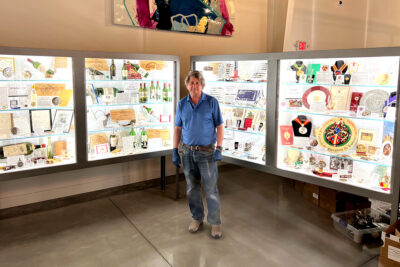
“You know how when you get your first car, you’re looking for any excuse to go driving around, you know, go to the grocery store for your mom or anything,” Scott said. “I just had my first car, turned 16 for about a month, and I went down to some antique stores on South Broadway in Denver and bought my first corkscrew, and that kind of started it.”
That corkscrew is in one of the many Colterris Collections display cases and is in its own small cube with a card next to it that reads: “First Corkscrew in The Colterris Collections 1971.”
The explanatory cards, by the way, are plentiful in the display cases, providing details and stories. If you read all of the cards as you go from one display to the next, Scott doubts you can get through the private collection in one day.
Most likely, people will save the intensive reading for displays that interest them the most.
“I think there’s something in here for almost everybody,” Scott said. “They’ve just got to find what their interests are.”
One of the reasons for displaying and opening the private collection to the public, Scott said, is “a lot more people are interested in history now, and I’m kind of surprised. Twenty years ago, I couldn’t find anybody who cared about history, and now it seems like there’s a resurgence in interest, which is good.”
Scott’s interest in history is obvious when he walks among the displays and points out items he finds particularly interesting.

Among those items were:
- A bottle from 300 A.D.
- Corkscrews made from antlers and tusks.
- Colored wine glasses, including three blue glasses that “were gilded by James Giles himself in London,” Scott said. “And he did those about 1765, but he actually painted all that gold on each one of those glasses.”
- Georgian stemmed glasses that have extremely thick bottoms, because in the 1700s, you would bang them on the table. “Instead of clapping,” Scott said, “you’d bang – ‘Here, here,’ you know – to a toast or something, so they were thick, so you could bang on the table. And then in 1745, the British changed the tax laws on glass blowers, and so they stopped making them so thick, because they had to pay higher duty.”
- A deception glass, which Scott said, “If you look at the bottom, it’s really thick. So, a toastmaster that was presenting for an evening in Britain, they’d do a toast to the king, a toast to the prince regent, a toast to the lord mayor. They have all these toasts, and so if the toastmaster was drinking the same amount as everybody else, he would not be able to do the toast after a while. So he drank about half as much as everybody else, because the glass is so thick. So that’s a real rarity there. To have that in that condition is really beautiful.”
- Corkscrews from the Black Forest that are “probably close to 100 years old.”
- A bottle of wine that was recommended by Duncan Hines. Yes, that’s the same Duncan Hines better known for cake mixes.
- A variety of jugs from Colorado, of which Scott said, “They’re very rare. Leadville, Walsenburg, Florence, Denver, Glenwood Springs, Montrose, Trinidad, Salida. They all tell a story, but they’re about 110 and 120 years old.”
- A beer can from the first company to put beer and ale in cans: the Gottfried Krueger Brewing Company in Newark, N.J.
- A beer-tasting cup that Adolphus Busch gave to his son, Carl, on his 21st birthday. “See the initials, CLB, St. Louis, Missouri,” Scott said. “So, that goes back to about 1912, I think.”
- A display case devoted to Napoleon Bonaparte, and Scott pointed to a glass bottle with a clean break near the top of the neck and said, “Napoleon Bonaparte was obviously a big champagne guy, and when his troops won a battle, they were given bottles of champagne when they came back into Paris. And the cavalry, in particular, would take those cavalry sabers, smack the tops of the bottles off to look like that.” That technique, by the way, is called sabrage.
- A corkscrew recovered from the Battle of Waterloo, and Scott said it “might be the only one in existence.”
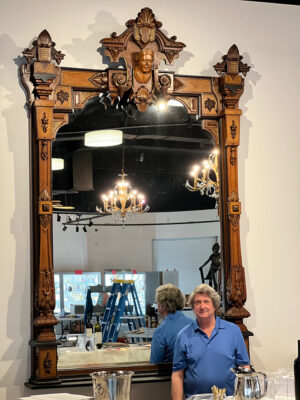
At one point, Scott said, “I think I’m probably telling you more than you’d care to know about.”
His assumption was incorrect. The collection is filled with fascinating items, and there isn’t a better guide for it than the man who spent 54 years putting it together.
WHEN CAN YOU SEE IT?
Colterris Collections’ private collection, 3708 G Road (also U.S. 6), will open to the public on June 23, co-owner Scott High said.
High said in early June he thinks admission will be $20, and Colterris wine club members will get a reduced rate of $15.
DON’T CALL IT A MUSEUM
Scott High knows people will call Colterris Collections a museum, but he doesn’t.
“We just call it a private collection,” he said. “You come experience a private collection of objects.
“And the museum, for my generation it connotates that I was going somewhere in a yellow school bus, and the teacher made me get off and stand in a single file and be quiet until I went into the museum, and I couldn’t ask any questions or anything, just had to look and listen.
“I guess technically it’s a museum, but it’s a private collection.”
THE GIANT MIRROR
High said the thing people ask about the most in the private collection is the giant mirror, and while his wife, Theresa High, didn’t want to be part of the interview Scott gave to The Business Times, she provided the story behind the mirror.
She said it originally was hanging in the Fairmont Hotel in San Francisco, and the hotel was scheduled to open for business with a ribbon cutting during the morning of the 1906 San Francisco earthquake. However, the earthquake occurred a few hours before the opening could take place, and the resulting fires in San Francisco damaged the Fairmont Hotel.
“This particular mirror was rescued from the fire, and right now, if you go into the Fairmont Hotel, you’ll see a replica of this,” Theresa said.
The Highs purchased the mirror more than 10 years ago, she said, and all of the carvings around it were smoke damaged. They decided to get it professionally cleaned a few months ago in anticipation of displaying it in the private collection, and that brought a nice surprise.
“They found by cleaning it, this is the original gold, gilding on the artwork there, the carvings around it, and that’s burlwood, and they cleaned it all up,” she said.
Pieces of the mirror were kept in separate boxes, and the cleaner put it together for the first time in well over 100 years, Theresa said.
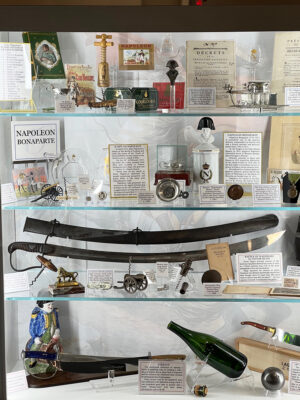
“And we got to see it in really its first life, because it’s never hung anywhere else, and no one’s ever really seen it in a public viewing until now,” she said. “And that is the original glass, so this is probably one of the most historical pieces … it’s a very historical piece for the United States and particularly California.”
NO PUTTING A PRICE ON IT
When asked if he had any idea what the entire private collection’s value is, Scott High said he doesn’t know because he never tried to calculate it, and he won’t.
“It was purchased over a 50-year time period and one item at a time,” he said. “So, I can add up quickly how much I have in a cabinet, and then I can add up how much it’s worth if I want to, but I don’t really want to get into the value.”
He added, “People ask me two questions: What did you pay for that, and how did you get it? Well, those are the two questions I’m probably not inclined to answer. It’s interesting, but that’s not the enjoyment of seeing the objects.”

